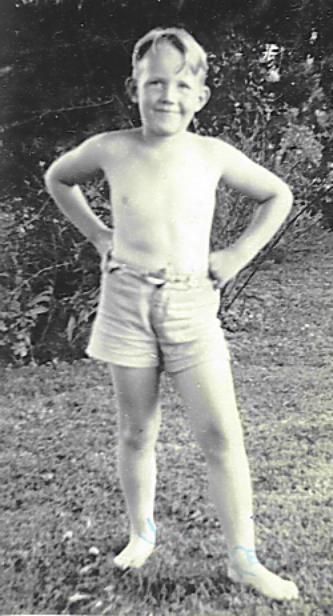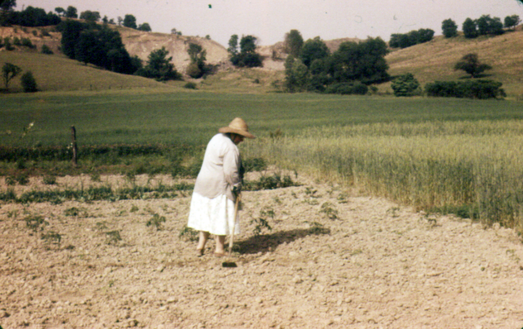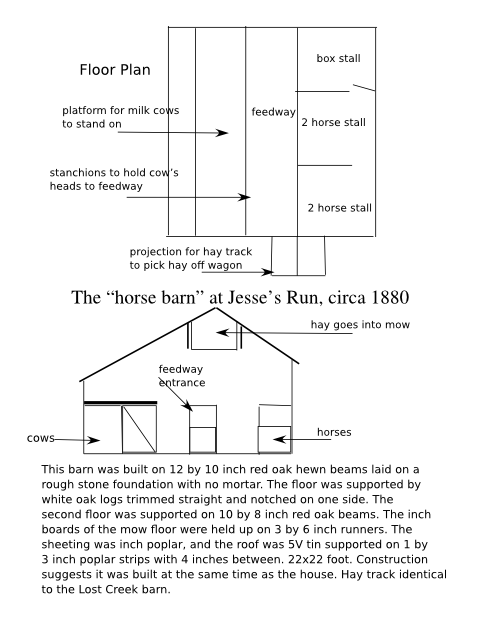
| Next Chapter | Previous Chapter | |
| Chapter 9: How Haying Changed | Contents | Chapter 7: Ecological Changes |
I remember being taken out to make shocks of hay
(Illustration 8-1)

"Start 'em young, grow em up right"
in the field behind Aunt Lotta's House, presently occupied by Aunt Ann, my sister, and Uncle Dallas. The pitchfork was taller than I was, and I had to work beside mother - I was possibly eight or nine years old at the time. Mom always enjoyed working outdoors, and helped in the hay at times. The hotter it was, the better she liked it, I decided in later years.
I have a very fair complexion, so I had to wear full length sleeves, and, of course, you make hay when it gets dry, before it can rain, when it is hot. The hay was raked up by a horse (dump) rake. This consisted of steel rods curved like raking fingers, set three or four inches apart, about 10 feet wide. At the ends of this were steel wheels about four feet high. The rake teeth hung down from a bar from the center of one wheel to the center of the other. The operator sat on a seat above this bar to drive the horse, and there was a pedal to dump the rake. When the operator pushed on the pedal, a ratchet engaged a cog wheel built into each large end wheel, and this lifted the rake teeth to dump it. The ratchet kicked out when rake teeth reached the top, A skilled operator could make a straight line by going back and forth across the field and dumping at the right time. (See Illustration 51-1)
(Illustration 8-2)

Mom in the garden in midafternoon about 1956. Stripping in progress in the background by Byron Construction, Tony Petito, for Don Harrold
The next step was for someone to come along with a pitchfork, pick up hay from the windrow, and make a small pile of the hay. Each pile was the grass that grew on a space of approximately 200 square feet. They were built to shed rain, like a hay stack, in case the hay didn't get in the barn until the next day. What we used was really a manure fork, with four tines, rather than three forks, which was the number for a true pitchfork. Usually there would be half a dozen people "making shocks."
At our farm the hay went into the barn. A hay wagon came by the shocks of hay were picked up with a fork, and put on the wagon. The driver would build the load so that it would not fall off. As best as I can remember, the flat surface of the wagon was about six feet wide and fourteen feet long. The wheels were steel, four inches wide and about two and half feet high. They were five feet four inches apart, center to center, and so are railroad tracks and so are "full size cars" today. Some of the people we worked with had wagons with back wheels somewhat higher. This meant the bed was also higher, so the load could not be so high. I never saw a wagon with high wooden wheels of the type you see in movies. They had been around in my father's youth but had passed on.
Once the wagon was loaded it was driven into the barn. The advantage of the lane through the barn was that the last wagon could be left for the next day, or unloaded in the dry, if it started to rain. Most barns were filled through a window in one end. In these barns the track was under a narrow roof extension that projected out past the end of the barn for six feet or so, to pick up the hay from a wagon, like the one at Jesse Run shown below.
Where did the labor come from? Some of it was hired, but much came from trading with other farm families. I will have more to say about this later.
As time passed I got inured to the heat, so Mom gave up trying to get me to wear long sleeves, and I began to like the whole thing - technology, social relations, and the exercise.
Aside A milestone reached in March 2004. We got our first advertisement from China, via the internet. It was an offer to become a dealer for a motor scooter. Not very practical for rural West Virginia. The world is shrinking, though.
(Illustration 8-3)

Horse Barn
| Next Chapter | Previous Chapter | |
| Chapter 9: How Haying Changed | Contents | Chapter 7: Ecological Changes |
Copyright © 1998, 2006, 2008, 2011 S. Tom Bond (stombond at hughes.net)